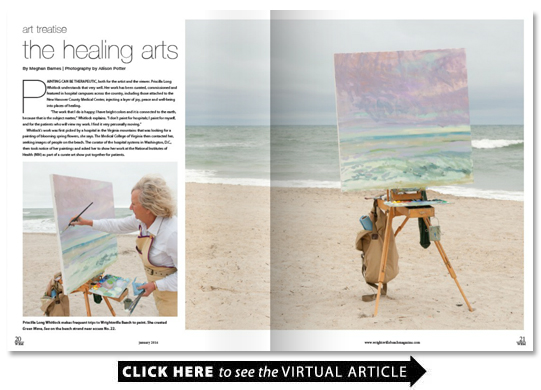The Healing Arts
BY Meghan Barnes
Painting can be therapeutic both for the artist and the viewer. Priscilla Long Whitlock understands that very well. Her work has been curated commissioned and featured in hospital campuses across the country including those attached to the New Hanover County Medical Center injecting a layer of joy peace and well-being into places of healing.
“The work that I do is happy; I have bright colors and it is connected to the earth because that is the subject matter ” Whitlock explains. “I don’t paint for hospitals; I paint for myself and for the patients who will view my work. I find it very personally moving.”
Whitlock’s work was first picked by a hospital in the Virginia mountains that was looking for a painting of blooming spring flowers she says. The Medical College of Virginia then contacted her seeking images of people on the beach. The curator of the hospital systems in Washington D.C. then took notice of her paintings and asked her to show her work at the National Institutes of Health (NIH) as part of a curate art show put together for patients.
Some of Whitlock’s work is solely featured in patient-only sections of the hospital. These are places that encourage growth and exploration while healing a process encouraged by the vibrantly colored oil paintings. Her work is also featured in various cancer centers and other places where they can provide comfort and solace to the individuals awaiting treatment.
The patients often find her work moving sometimes contacting her to tell her how she has influenced and inspired their journey to recovery.
Although Whitlock did not receive any classical training some would say art is in her blood. Growing up in the coastal North Carolina region surrounding Wrightsville Beach she often experienced dramatic sunsets vivid marsh landscapes and vibrant waters.
“I have been painting in Wrightsville Beach since the late 1970s and I used to paint there with my father. I have a lot of family in the area. I am drawn to the marshes the water the sky and the landscape. I have even painted in the rain ” Whitlock explains. “There is a huge sky in North Carolina and of course the water in Wrightsville Beach is always beautiful.”
Many of her paintings depict the same coastal landscapes but the lighting setting and mood all vary dramatically. That is why Whitlock always travels with a small painting kit and easel. And after being married to her husband for many years he understands when she asks him to pull over onto the side of the road so she can go explore the light and shading of an area. He is always willing to wait for her as she decides if she will paint that landscape or not.
“Recently I was driving to Wrightsville Beach with my husband and I saw these beautiful glowing yellow fields off in the distance ” Whitlock says. “So I said ‘Will you please go over there and find those fields?’ Once I found them I went back multiple times and painted them.”
Some of her fondest memories are of the times spent painting with her dad.
“It was wonderful growing up and painting with my father. He started painting when I was in college at East Carolina University ” Whitlock recalls. “We would go and paint boats at the marina we would go paint somewhere along the Cape Fear River or onto one of the small islands around Topsail or we would take his small boat and go find a small secluded island.”
Those experiences have carried her throughout her artistic career. Whitlock still ventures out onto the islands that surround Wrightsville Beach in her husband’s small boat looking for the perfect inspiration for her next piece. She can be found exploring the marsh looking at the way the light hits certain patches of sand or finding a sheltered nook away from the wind to paint it.
Even though she has a steady following of local national and international viewers Whitlock does not stop exploring the different ways she can make art or the different ways she can capture the unique elements of coastal North Carolina.
“My work has changed over the years ” she says. “It used to be more realistic and now it is more abstract but it is still based in realism. And I guess it will always be changing.”
